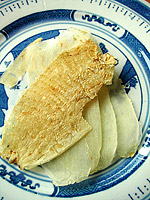|
 |
| Tall gastrodia tuber |
|
| Name |
Latin Name: Rhizoma Gastrodiae
Common Name: Tall gastrodia tuber
Scientific Name: Gastrodia elata Bl.
Chinese Name: §—≥¬
Pinyin Name: tian ma |
| Top |
|
| Origin |
| The tuber of Gastrodia elata Bl., a saprophytic perennial plant of the Orchidaceae family.[1] |
| Top |
|
| Where Does It Grow? |
| Tall gastrodia tuber is widely distributed in North and South China. It is mainly cultivated and produced in provinces like Guizhou, Shanxi, Sichuan, Yunnan, and Hubei nowadays. There are many fake products in the market, be cautious in choosing the providers.[3]' [5] |
| Top |
| Nature and Flavor |
| Tall gastrodia tuber is neutral in nature, sweet in flavor, and mainly manifests its therapeutic actions in the liver meridian.[2] |
| Top |
|
| Identified Active Components/ Major Chemical Constituents |
Tall gastrodia tuber contains phenolic compounds and glycosides derivatives, in which gastrodin is the major active component and is about 0.025%. Other components are gastrodioside, vanillyl alcohol, vanilline, polysaccharides, minerals, alkaloids, vitamin A components and anti-fungus protein. Gastrodin, gastrodigenin and the similar components can now be produced artificially.[4]' [5]' [7]
In the Pharmacopoeia of People's Republic of China (2010 Edition) - Part I, the level of gastrodin should not less than 0.20%, which is the standard quality of tall gastrodia tuber. |
| Top |
|
| Drug actions in TCM |
| Tall gastrodia tuber can pacify liver, extinguish wind, and unblock collaterals to easy pain.[4] |
| Top |
|
| Traditional Use in TCM |
Tall gastrodia tuber is often used in conditions like dizziness, headaches, paralysis, limb numbness, muscle spasm, convulsion and painful joints.[2]' [3]' [4]
Tall gastrodia tuber is an important ingredient for dizziness and headaches
Dizziness and headache are often associated with wind pathologies in TCM, and tall gastrodia tuber is specialized in dispelling the pathogens. For different types of headache, the herb is selected along with Sichuan lovage rhizome and vitex fruit in the remedies. When hypertensive individuals develop headache and dizziness, tall gastrodia tuber can work with abalone shell, gambir vine stem and twotoothed achyranthes root to pacify a hyperactive liver and relieve the discomforts. For individuals with inner ear disorder that leads to frequent loss of balance, and dizziness, tall gastrodia tuber can work with pinellia tuber, largehead atractylodes rhizome and poria to clear wind and phlegm pathogens in the head region.
Tall gastrodia tuber for stroke complications
Stroke that leads to paralysis and speech difficulty, tall gastrodia tuber can work with red sage root, red peony root, pinellia tuber (processed with ginger), earthworm and Sichuan lovage rhizome.
Tall gastrodia tuber enters liver meridian, which is related to muscle spasm problems
Liver blood deficiency can cause wind symptoms like limb cramps, major muscle spasm or epilepsy. Tall gastrodia tuber can work with scorpion, gambir vine stem, buffalo horn, acorus and polygala root to relieve feverish convulsion or epilepsy attacks in children, for the long lasing cases, it is suitable to use tall gastrodia tuber, pilose asiabell root, largehead atractylodes rhizome, and silkworm to relieve the painful condition and reduce attacks. Tall gastrodia tuber can work with arisaema with bile, aconite root and ledebouriella root to treat muscle spasms due to tetanus.
Tall gastrodia tuber unblocks the collaterals to easy pain
For painful joint and limb numbness, tall gastrodia tuber usually works with notopterygium root, pubescent angelica root, gentiana macrophylla root, Sichuan lovage rhizome, angelica root and twotoothed achyranthes root for relief.
|
| Top |
|
| Pharmacological Actions |
| Researches show that tall gastrodia tuber helps calm down the brain, easy pain, relieve muscle spasm, protect heart and liver functioning, lower blood pressure, improve blood circulation, anti-inflammation, enhance immunity, anti-aging, anti-hypoxia, increase skin temperature and stimulate intestinal activities.[4]' [5] |
| Top |
| Toxicology |
| Tall gastrodia tuber extract injected (i.p.) in mice, the LD50 was 51.4g°„61.4g/kg. Tall gastrodia tuber decoction injected (i.p.) 12g/kg in rabbits, slow response were seen after half hour, and then developed incoordination, refusing to eat, and fast heart beating, the animals died mostly within 48 hours.[4] |
| Top |
|
| Administration and Dosage |
| Orally, the daily dose is 3-10g. Tall gastrodia tuber cannot be cooked for long time, since its main active ingredient °V gastrodin is volatile, and thus physicians may suggest taking in powder form.[5] |
| Top |
|
| Adverse Effect, Side Effects and Cautions |
| Individuals with severe conditions should use with caution. It is reported that a very high dosage can lead to headache, hot feeling in face, coma and slow papillary light reflex.[6]' [7] |
| Top |
| References |
| 1. |
Li Jiashi (editor-in-chief), Chinese Medicine Identification, Shanghai Scientific and Technical Publishers, 2000-2. |
|
|
| 2. |
Lui Daiquan (editor-in-chief), Chinese Herbal Medicine, Shanghai Scientific and Technical Publishers, 2000-6. |
|
|
| 3. |
Tao Yufeng, Clinical Herbal Medicine, People°¶s Medical Publishing House, 2005-5. |
|
|
| 4. |
Chen Pian, Clinical Application of Tonifying Herbs, Second Military Medical University Press, 2008. |
|
|
| 5. |
Zhao Zhongzhen & Xiao Peigen (editor-in-chief), Contemporary Medicinal Herbal Glossary, Hong Kong Jockey Club Institute of Chinese Medicine, 2006-8. |
|
|
| 6. |
Song Zicheng (editor-in-chief), Handbook for Quick Search On the Risk of Chinese Medicine, Chung Hwa Book Co., 2004. |
|
|
| 7. |
http://www.zysj.com.cn/zhongyaocai/yaocai_t/tianma.html |
|
| Top |
|
|
|
|